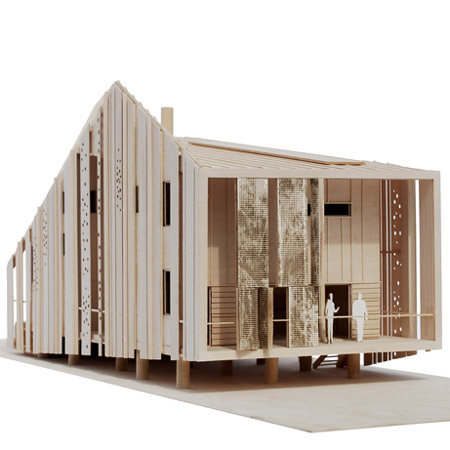
Duplex by Pugh + Scarpa for Make it Right
American architects Pugh + Scarpa have sent images of their duplex home design for actor Brad Pitt's Make it Right charity.
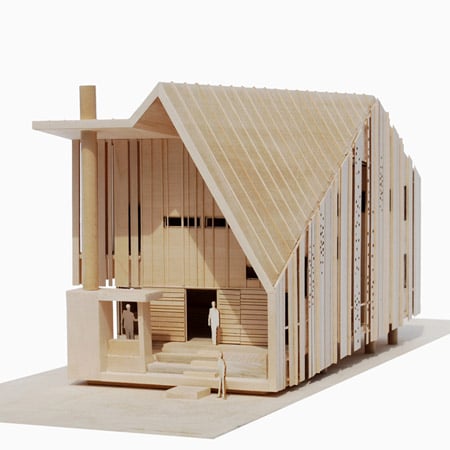
They are among 14 local and international architects to have designed multi-family homes to rehouse people who lost their homes when hurricane Katrina destroyed the Lower 9th Ward in New Orleans.
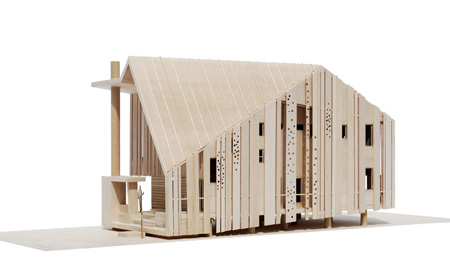
More info about Make it Right in our earlier story. See also our story about Frank Gehry's duplex design for Make it Right.
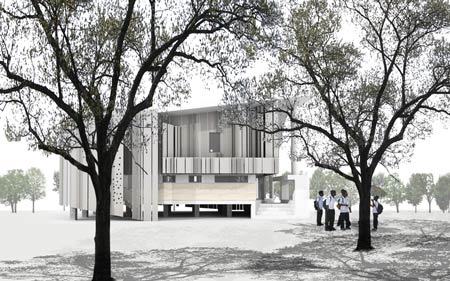
Here's some info from Pugh + Scarpa:
--
PUGH + SCARPA PUSHES "GREEN" EDGE IN DESIGN OF DUPLEX IN THE LOWER 9TH WARD
NEW ORLEANS, Louisiana, July 1, 2009 Bicoastal, cutting-edge architecture firm, Pugh + Scarpa is pleased to announce the release of its design for a duplex home for Make It Right, a nonprofit foundation established by actor Brad Pitt to help rebuild the Lower 9th Ward of New Orleans after Hurricane Katrina.
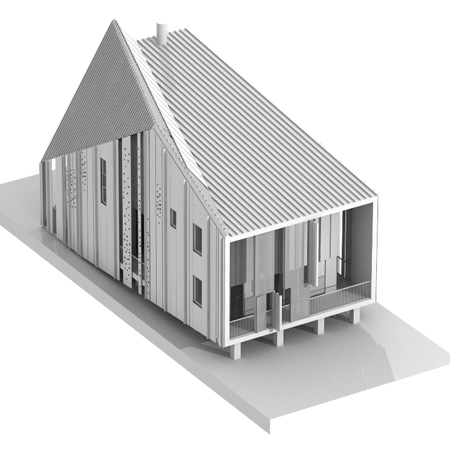
addressing the needs of today’s modern family, on a limited budget. Offering shelter and comfort, the MIR home breaks the prescriptive mold of the traditional home by creating public and private “zones” in which public areas and social integration with the neighborhood are emphasized. The organization of the space is intended to transform the way people live―away from a reclusive, isolating layout toward a family-oriented, interactive space.
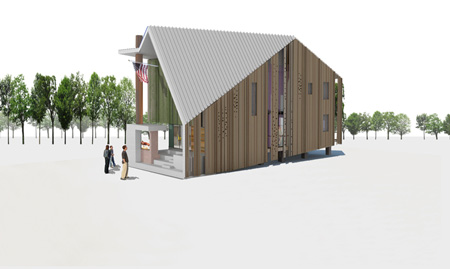
When Katrina ravaged New Orleans, citizens were displaced from their homes, waited months to return home, and suffered further demoralizing setbacks, as officials discussed demolishing and abandoning entire neighborhoods that residents had worked so hard to create. The central concept of our new duplex home is the restoration of “pride of place” to those districts hardest-hit by the hurricane.
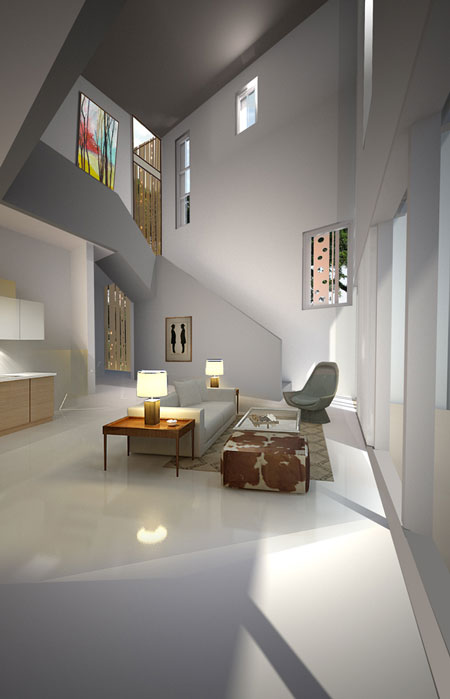
The house accomplishes this with several significant design moves: The front porch, facing the street, provides a gathering place for
neighborhood residents and relatives, and is divided into distinctive sub-zones: a platform for outdoor cooking and access to the home, front
steps with bleacher-like seating areas, and a platform just big enough for two rocking chairs to take in the life on the street. The inviting flames,
porch and sheltering roof work together to make the home the social locus of the neighborhood. Rather than isolating the home from its Lower 9th Ward neighbors this connection is an attempt to strengthen the social network of the neighborhood.
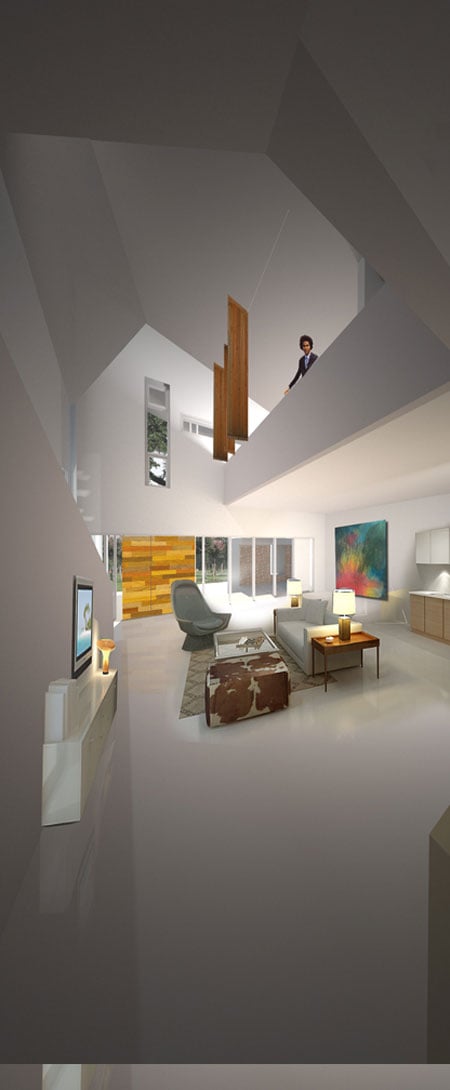
The scale of the porch is purposefully oversized and grand. Topping out at 38 feet above grade, the structure is meant to stand tall and proud as a symbol of neighborhood and city pride. The verticality and focal strength of the home is emphasized by the presence of a 12-foot high outdoor “cook pit” integrated into the front porch, facing the street. The “cook pit” is made for outdoor grilling and barbecues, with open flames visible from the street at eye level, and a rotisserie enclosure accessed from the porch.
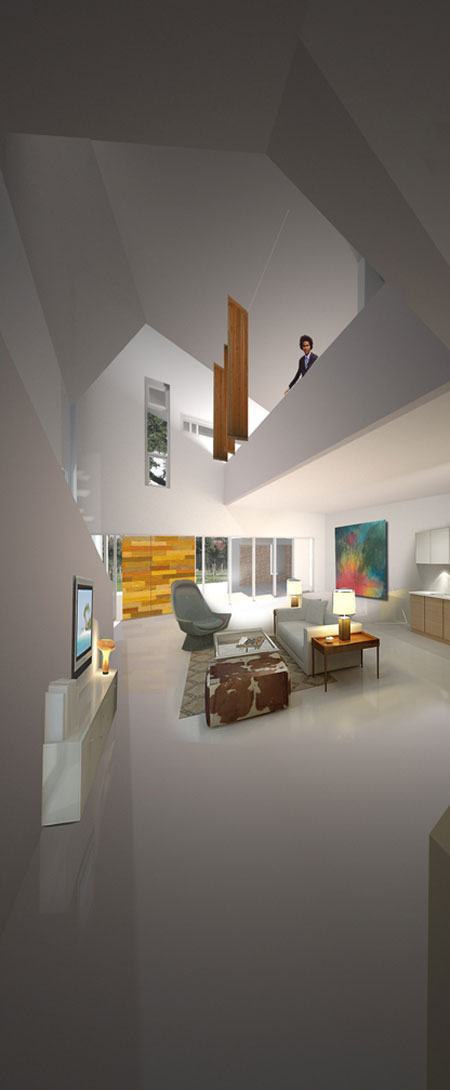
A chimney extends from the hearth enclosure past the roofline, acting as the home’s axis mundi and providing the armature for the required egress ladder for rooftop flood refuge. The porch also includes step seating to engage the street. Even though the house is five feet above the street, the porch reaches down to grade and makes a direct connection between the house and street connecting the families of the duplex directly to the street while simultaneously providing a welcoming symbol to the neighborhood.
Many of the design elements play this double role; the chimney acts both as an anchor and an escape; the porch is a refuge and a social gathering place; the cook pit is both a private and public hearth. The organization of the overall plan mediates between public and private objectives in a relatively small space.
On the ground floor, the back porch and yard have a significantly more private and enclosed feel than does the front porch and yard, yet movement between the two is fluid along the south side of the house. Residents of each unit can use the other’s porch without passing through the associated unit. The two units are also internally and externally connected by small exterior private porch to the north and by a pair of individually locked doors that can be opened to expand the two units into one for larger gatherings. The disposition of these units is ideal for extended families that still require a level of privacy.
Pugh + Scarpa’s approach to Cradle to Cradle sustainability begins with passive solar design strategies such as locating and orienting the building to control solar cooling and heat loads; shaping and orienting the building for exposure to prevailing winds; shaping the building to induce buoyancy for natural ventilation; and shaping and planning the interior to enhance daylight and natural air flow distribution. The roof pitches upward from at an angle that both announces the home to the street and induces air flow upwards through clerestory windows set just below the roofline. On the exterior, vertically oriented, patterned paneling reinforces the home’s height. Inside, a double-height space brings light, airflow and a sense of commodiousness to the living room.
The building responds to the specific conditions of the New Orleans climate in several ways:
·On the south side deep overhangs provide passive solar protection for the building’s interior.
·Similarly, openings on the east and west sides are protected with deeper overhangs and porches.
·The north side is allowed to be flat and exposed, which affords daylighting with a minimum of solar heat gain.
The roof is sloped to induce airflow.
High ceilings and abundant cross ventilation allow heat to escape the building’s interior. Cooling airflow inside the home is enhanced by ceiling
fans, a direct drive exhaust fan, and operable windows, which create abundant cross ventilation.
All materials selected are commercially available, cost-effective, and eco-friendly.
All appliances are “Energy Star” rated.
The home’s high ceilings promote an airy, spacious ambiance, and will be less reliant on electric lighting than a conventional home.
Pugh + Scarpa is joined by 13 other acclaimed architects in the second wave of designs for Make It Right. Pugh + Scarpa also participated in the first wave, which focused on developing sustainable, affordable single-family homes for the Lower 9th Ward.
About Pugh + Scarpa:
Pugh + Scarpa is an architecture, engineering, interior design, and planning firm founded in Santa Monica in 1991 and maintains offices in Santa Monica, California and Charlotte, North Carolina. Gwynne Pugh, AIA, ASCE, LEED AP, Lawrence Scarpa, AIA, and Angela Brooks, AIA, LEED AP, are the sole principals and the firm is consciously structured to ensure their participation in each project. The firm has received 13 National AIA Awards and more than 40 state and local awards, and is recognized as a leader in contemporary, sustainable design.
For publication inquiries about Make-it-Right and information on Pugh + Scarpa, contact Daniel Safarik at (310) 828-0226 ext. 16 or access our
website at www.pugh-scarpa.com.
About Make It Right:
The Make It Right Foundation is committed to building 150 energy efficient, solar powered, storm resistant homes in New Orleans Lower 9th Ward, a neighborhood wiped out by Hurricane Katrina and the breach of the Industrial Canal levee. The Foundation began in December 2007 as a collaboration between actor Brad Pitt, Graft Architects, Cherokee Gives Back and William McDonough + Partners*. Today 32 families are either living in a Make It Right home or have one under construction. Another fifty Lower 9th Ward families are in the process of becoming a Make It Right homeowner.
For more information: www.makeitrightnola.org